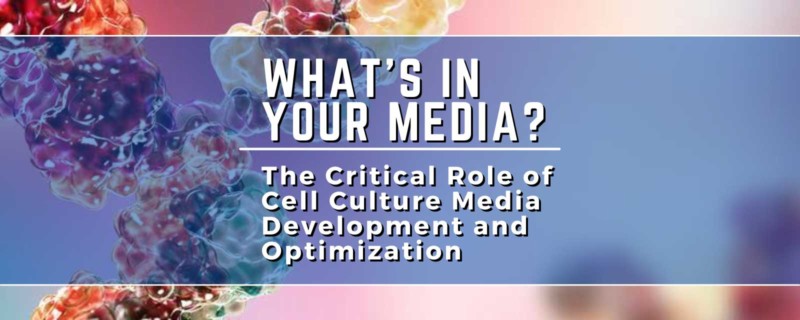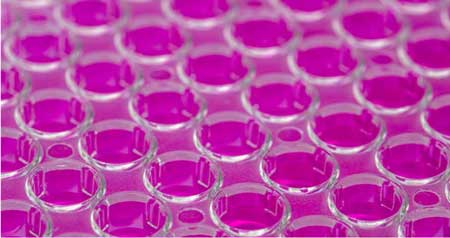
The Critical Role of Cell Culture Media Development and Optimization
 This article was originally published in the eBook
This article was originally published in the eBook“What’s In Your Media”.
You can download all the articles in the series, by downloading the eBook.
Cell culture media remains a key component of biologics-based therapeutics manufacturing. As such, cell culture media development and optimization continue to be important focuses for the biopharmaceutical industry. Increased analytics capabilities have provided new insights into the relationship between cell culture media, the cells they support, and ultimately, the outcome of the final biologics product. That greater insight offers more opportunities to create products faster, more cost effectively, and with greater therapeutic success.
Media development and optimization are critical when looking to streamline biotherapeutic process development. Analyzing how cells consume medium components provides valuable information about the health and productivity of the overall production process. Analysis of key media components — such as amino acids, vitamins, and the metabolites produced as a result of cell growth — is beneficial at all stages of process development, including cell line development, media development, and process optimization. This information provides insight not just on media composition and performance, but also on clone selection, optimal harvest time, potential product quality issues, purification strategies, and more.
Diversity of Biotherapeutic Manufacturing Media
Biotherapeutics is a broad term that encompasses more traditional protein-based biologics like monoclonal antibodies, and also newer therapeutics including cell and gene therapies. These biotherapeutics represent different medical modalities and can address different therapeutic indications as well. They also employ distinct therapeutic vehicles, thus requiring separate manufacturing practices. For instance, with protein-based biologics like antibodies, the final product is not the cells, but the proteins that the cells produce. For cell therapies, the cell is the therapeutic, and for viral vector-based gene therapies, viral vectors are the key component.
Producing these diverse therapeutics, requires that various cells be used based on the specific application. Since various cells have different requirements, the medium used to culture them must be designed for optimal growth and/or productivity of each cell type. When the composition of the cell culture medium does not match the cells’ requirements, manufacturing productivity and product quality attributes can suffer. Therefore, medium must be developed and optimized for each cell type and cell clone.
In this publication, we will look at the different media requirements and optimization strategies for three types of biologics: protein-based biologics, cell therapies, and gene therapies.

Protein-based Biologics Media
Bioproduction media has been under development and optimized for decades. Chinese hamster ovary (CHO) cells are the most popular choice for commercial production of protein therapeutics, such as monoclonal antibodies (mAbs). Other cell lines such as HEK293 and Vero, also play an important role in the therapeutic space and they are commonly used to produce non-mAb products such globular proteins, viral therapeutics, and vaccines.
Bioproduction media has traditionally been refined by first removing serum, then removing animal-components and other undefined components such as hydrolysates, and finally developing chemically-defined formulations. Our increased understanding of the relationship between cells and the cell culture environment has resulted in vastly improved cell productivity, growth and viability. For instance, mAb titer has been increased from ~ 1g/L to greater than 10 g/L in some instances. In addition, we now know that mAb product quality attributes such as glycosylation patterns, aggregation, charge variants and stability are affected by media composition. Thus, media development and optimization is critically important and can have a dramatic impact on the manufacturability of a product for commercialization.
A typical bioproduction medium optimization effort involves multiple levels of optimization through analysis of spent media and monitoring the effect of supplementation or reduction of individual components on the desired outcome of the culture. Optimization can be a complex and a time-consuming experience due to the large number of possible medium components and the even greater number of possible concentration-dependent combinations. Design of experiment (DOE) can be utilized to reduce the workload, however analysis of each of the possible combinations is still required.

Cell Therapy Media
There are multiple cell types used for cell therapy production. Since each cell type has unique requirements that impact their growth, viability, and functionality, and since the cell itself is the therapy, careful consideration of media components is necessary. For instance, removing serum from media formulations is a particular concern due to the increased risk associated with animal-derived components in media for clinical or commercial manufacturing. The use of any animal-derived product in medium, including serum, increases the risk of contamination, supply chain instability, and variability. In addition, there is the possibility of introducing adventitious agents, including viruses or prions that may be present in the cells for the final product. However, developing a media without serum or optimizing a media to remove or reduce serum is complex and requires extensive knowledge, time, and resources to complete. Since timelines for cell and gene therapies are frequently constrained compared to protein-based biologics, it makes the task that much more challenging.
Unlike protein-based biologics manufacturing where established, clonal cell lines are utilized, cell therapies using primary and stem cells present unique challenges particularly in autologous settings. The degree of ex vivo cell expansion, differentiation, and functional activation can vary significantly from patient to patient where the starting cells are limited and are often in poor health. Because cell culture media formulations determine cell characteristics (i.e., growth kinetics, health status and functional properties), there is renewed interest in metabolomics to better understand the impact of various media additives such as glucose, amino acids, vitamins, and dipeptides, on critical quality attributes (CQAs) that influence therapeutic efficacy.
Viral Vector Production Media for Gene Therapies
Gene therapies treat diseases through genetic modification, most often taking the form of genetically engineered viral vectors used to deliver a genetic payload to the cells. There are non-viral methods in development; however, viral vectors are still the most popular approach.
Efficient viral vector production is a key element for gene therapy manufacturing success and there is currently a push to meet the high demand for viral vectors. Thus, the industry must transition from small to large-scale commercial manufacturing and increase viral titer production, while still maintaining critical quality attributes. The complexity of viral vectors, significantly more complex than recombinant proteins, has posed biomanufacturing challenges both upstream and downstream including scalability, productivity, and overall lack of robustness. To develop long-term solutions to these problems, manufacturers are looking to optimize both the producer cells and the culture media they are grown in.
Understanding cell metabolism and the impact of medium components, like amino acids and glucose, on titer levels can be done using media analysis studies and is key to increasing productivity. Ideally, the media selected should provide the essential nutrients to facilitate high productivity, consistency and quality as well as being amenable to support scale up to larger manufacturing platforms.

Media Analysis to Enable Development and Optimization
What each of these therapeutic manufacturing processes have in common is the need for in-depth analysis of the impact that the medium has on cells in culture, and consequently, the final product. While each may have different process challenges, productivity targets, and manufacturing requirements, the need to develop and optimize a media specifically designed for that application is universal.
In each scenario, product quality is critical when examining the relationship between media components, how those components are consumed, metabolites produced, and the overall impact on growth, and productivity. While spent media analysis data is vital to moving media development and optimization forward, it can be difficult and expensive to obtain in a timely matter. Frequently, process development groups do not have the analytical tools or resources in their lab to engage in the in-depth analysis required. This means sending samples to on-site or off-site labs for analysis. Outsourcing can take days to weeks to obtain results and can be quite costly. This results in PD groups having to make difficult decisions about the number and frequency of samples that can be sent for analysis. Inevitably, this creates delays in process development and an incomplete picture of what is happening in culture.
A better solution is at-line spent media analysis. Real-time analysis also supports process analytics technology (PAT) initiatives through monitoring and maintaining critical quality attributes to ensure product quality and batch-to-batch consistency. Waiting until the end of a culture run for spent media analysis results does not inform operators about the day-to-day process nuances. Running this analysis in real-time speeds process development and opens up the possibility to affect change in real-time instead of having to wait for the next run to implement changes.
The large number of samples generated when using a microbioreactor system can also put a strain on analytics resources. The development of scaled-down bioreactor models for media development has been a breakthrough in that they permit simultaneous testing of many different culture conditions in a fraction of the time. However, the number of samples generated is substantial, and the volume of these microbioreactors is small, thus creating another bottleneck and limiting the ability to run samples daily.
To address the challenge of obtaining at-line media analysis, microfluidic analysis technologies have been developed to allow for measurement next to the bioreactor. One such device is the REBEL analyzer which combines capillary electrophoresis with high-pressure mass spectrometry. An analyzer like the REBEL provides several advantages over classical analytical methods by providing near-instantaneous readings at-line, and with a simple-to-operate interface within a small footprint. The near real-time monitoring of CQAs has direct implications on the therapeutic efficacy, safety, product quality, and batch-to-batch consistency. These advances in medium analysis should support the industry “into the future with expanded capabilities in process modeling and predictability to not only ensure high productivity with consistent product quality but also provide process control.
For more information, please download the ebook – What’s In Your Media